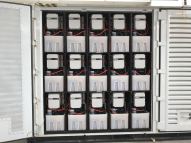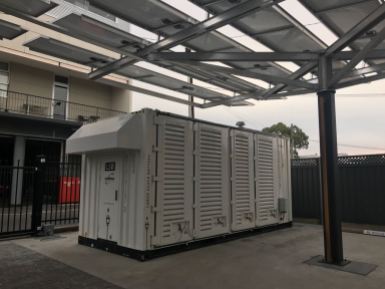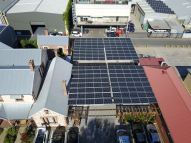About The Vale
The Vale is a 170 Acre farm in the NorthWest of Tasmania. It is located in a river valley in the shadow of Mount Roland.
Various crops are grown on the property along with the running of sheep and cattle. The property also features a large private runway.


We wanted to future-proof the property in terms of electrical energy self-sufficiency by building a large renewable energy system.
Here is what we built…
System Components
- Three phase grid feed via a 500KVA transformer (configured for up to 200kWp export)
- 200 Kilowatt Peak (kWp) ground-mounted solar array using LG 375W panels on Clenergy ground mount systems into 8 x 25kWp Fronius Symo AC Inverters
- Provision for future on-site generator
- 144 kW / 180 KVA Victron Energy Inverter/Charger array (12 x Victron Quattro 48/15000)
- 280 kWh of Flow Battery energy storage (28 x 10kWh Redflow ZBM2 zinc-bromide energy storage modules)
- Victron Cerbo GX system controller interfaced to 3 x Redflow Battery Management System units
- Underground sub-main distribution system servicing multiple houses, farm buildings and an aircraft hangar across the entire farm
- Underground site-wide single-mode optical fibre network serving site-wide indoor and outdoor WiFi access points and networked access control and building management systems
A shout-out to DMS Energy in Spreyton, Tasmania. I designed the system with them, and they built it all extremely well. The installation looks great and it works brilliantly.
Here is a gallery of images from the energy system






Flow Batteries
The system stores surplus energy in Redflow Zinc-Bromide flow batteries. These are a product that I have had a lot to do with over a long period (including as an investor in the company and as the the architect of the Redflow Battery Management System).
These batteries have a lot of advantages, compared to using Lithium batteries, for stationary energy storage applications such as this one.
You can read more about them on the Redflow site and also in various other blog posts here.
System Performance and Future Plans
Tasmania is interesting as a solar power deployment area, because it has the distinction (due to being a long way south!) of being the best place in Australia for solar production in summer, and the worst place in the country for solar production in winter!
This was a key driver for the decision to deploy a relatively large solar array, with the aim of obtaining adequate overall performance in the winter months.
The large solar array is also a renewable transport fuel station!
We already run one Tesla Model S sedan, a Polaris ‘Ranger’ electric ATV, and an electric aircraft on the property.
Our plan is to progressively eliminate the use of diesel on the property entirely, by running electric 4WD vehicles, electric tractors, and electric excavators as they become available on the Australian market. The beauty of the large on-site solar array is that all of these vehicles can be charging directly from on-site solar generation when they are not being driven.
During this winter, we’ve observed that we typically manage to half-fill the battery array, and that it then lasts about half the night before grid energy is required.
That’s why we are now in the midst of doubling the size of the solar array. Once we have done so, we will have a system that (even in mid winter) can supply all of the on-site energy demands of the property on most days, without drawing any grid energy at all.
Of course, in summer, we’ll be exporting plenty of energy (and being paid to do so). Even with the relatively small feed-in tariff offered in Tasmania, the system generates a reasonable commercial return on the solar array investment in non-winter months.
Here are some (summer time) screen shots from the on-site control system and from the outstanding Victron VRM site data logging portal.



On the image from the on-site Cerbo GX controller, you can see a point in time where the solar array was producing more than 90W, the battery array was mostly full and starting to roll back its charging rate, and plenty of that solar energy was also being exported to the grid.
The ‘System Overview’ and ‘Consumption’ charts show the outcome of all that sunshine…with the battery ending the day pretty much full, the site ran all night on ‘time shifted sunshine’ and started the following day half full, ready to be filled up once more.
We exported plenty of green energy to our neighbours and we used practically no inward grid energy at all.
Once we have doubled up the solar array size, we are looking forward to achieving a similar outcome on most winter days, not just during summer, along with exporting even more surplus green energy into the grid.
Once we have transitioned all the on-site vehicles to electric, our total export energy will diminish somewhat, but it will be more than offset by a $0.00 diesel fuel bill (and by zero CO2 and Diesel particulate emission from our on-site activities).
On-site Energy Efficiency
One thing that matters a great deal is to do the best you can in terms of energy consumption, not just energy generation and storage. To state the obvious: The less energy you need to use, the longer your battery lasts overnight.
All the houses on the farm are heated/cooled using heat pumps.
This is the most efficient way to do it, by far. It is often poorly understood just how much more efficient a heat pump is, compared to any other way to cool or heat something.
That’s simply because a heap pump doesn’t create the heat – rather, it moves heat energy in the outside environment into the house (or vice versa, to cool it). Typical values for the Coefficient of Performance (COP) – the ‘multiplier effect’ between kilowatts to run a heat pump and kilowatts of heat energy that can be moved – are of the order of 3-4 times. That literally means that 3-4 times as many kilowatts of heating or cooling are created than the number of kilowatts of energy put into the device to do it. By contrast, heating using an electrical ‘element’ has a COP of 1, meaning there is literally no multiplier effect at all.
Because we’re in Tasmania, and it does get cold in winter, we have put in a wonderful indulgence in the form of a Spa pool. These obviously need a fair bit of energy to keep the pool water hot, and we have done two things to minimise that energy draw.
First, we have used a Spa heat pump to do the hot water heating, which accesses that fantastic multiplier effect mentioned above. It means we are heating the water by just moving heat energy out of the surrounding air and into that water.
Second, we have installed an optional monitoring and control device so we can access the Spa and remotely control it. We can turn the heating off when we are leaving home, and we can then remotely turn the heating back on when we are heading back, so it is nice and hot when we arrive.
We have a third heat pump at our home, the one that heats our hot water. We are using a Sanden Heat Pump based hot water system that (also) performs really well.
On-site Energy Monitoring and Control
The key to optimising energy usage is to be able to actually measure it.
The Victron Energy Cerbo GX at the heart of the energy system monitors all aspects of our renewable power plant in detail (and uploads them for easy review to the no-extra-cost Victron Energy VRM portal). This gives us fantastic (and super detailed) visibility into energy generation, storage, and consumption on site.
However, we have a lot of separate buildings on the farm, and the key to understanding and optimising energy draw is to get deeper insight into which buildings are using energy and when.
To that end, we have installed many Carlo Gavazzi EM24 ethernet interfaced energy meters all around the site-wide underground power network. At each delivery point into a building, there is an ethernet-attached meter installed, so that energy usage can be narrowed down to each of these buildings with ease.
I am currently working on the design of an appropriate monitoring system that will draw this data in and use it to provide me with detailed analytics of where our energy is going on a per-building basis (and when!).
In terms of control we have deployed KNX based sensor and control devices in a variety of places around the property, and we plan to deploy much more of it. Over time, we’ll be able to dynamically control and optimise energy consumption in a variety of useful ways.
KNX is a whole separate story, but – in brief – its an extremely good way to implement building automation using a 30+ year old standardised protocol with full backwards compatibility for older devices and with support from over 500 hardware manufacturers. It allows for the successful deployment of totally ‘mix and match’ multi-vendor collection of the best devices for each desired building automation monitoring or control task.
We are continuing to learn as we go.
With the upcoming enhancements in site monitoring and control, we expect to deepen our understanding of where energy is being used, to (in turn) allow us to further optimise that usage, using techniques as simple as moving various high energy demands to run ‘under the solar curve’ wherever possible. These are the times when on-site energy usage is essentially ‘free’ (avoiding the ‘energy round trip’ via the battery, and leaving more battery capacity for energy demands that cannot be time-shifted overnight)
Summary
Overall, this system is performing extremely well, and we are extremely pleased with it.
When we have added even more solar, it will do even better.
The #1 tip – even in Tasmania – is clear: Just Add More Solar 🙂
The other big tip is to move your transport energy usage to electric.
The more electric vehicles we can deploy here over time (farm machinery as well as conventional cars), the better.
We’ll charge them (in the main) directly ‘under the solar curve’ and achieve a huge win-win in terms of both energy usage and carbon intensity.
As we keep learning and keep improving the monitoring and control systems… it will only get better from here.










You must be logged in to post a comment.